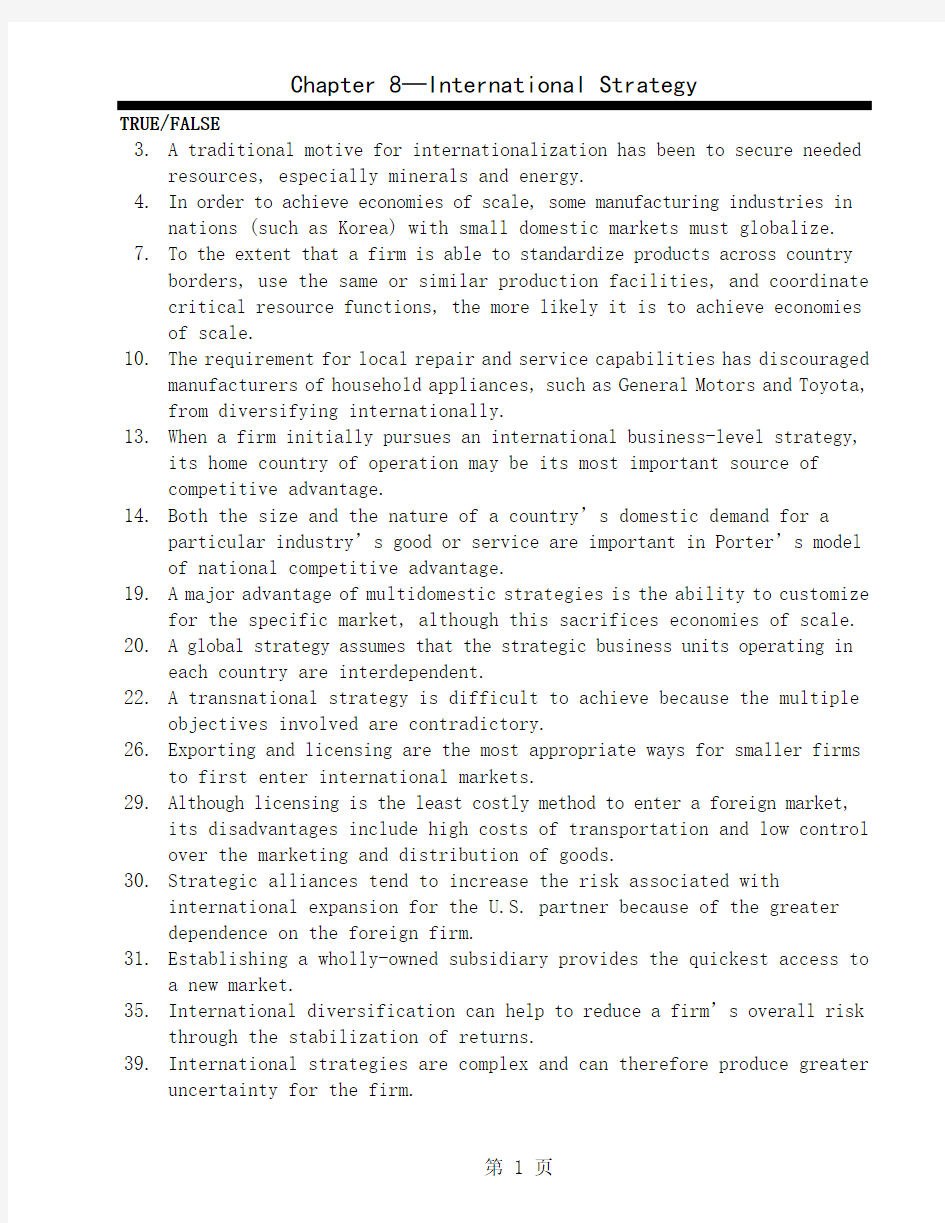

Chapter 8—International Strategy
TRUE/FALSE
3. A traditional motive for internationalization has been to secure needed
resources, especially minerals and energy.
4. In order to achieve economies of scale, some manufacturing industries in
nations (such as Korea) with small domestic markets must globalize.
7. To the extent that a firm is able to standardize products across country
borders, use the same or similar production facilities, and coordinate critical resource functions, the more likely it is to achieve economies of scale.
10. The requirement for local repair and service capabilities has discouraged
manufacturers of household appliances, such as General Motors and Toyota, from diversifying internationally.
13. When a firm initially pursues an international business-level strategy,
its home country of operation may be its most important source of
competitive advantage.
14. Both the size and the nature of a country’s domestic demand for a
particular industry’s good or service are important in Porter’s model of national competitive advantage.
19. A major advantage of multidomestic strategies is the ability to customize
for the specific market, although this sacrifices economies of scale.
20. A global strategy assumes that the strategic business units operating in
each country are interdependent.
22. A transnational strategy is difficult to achieve because the multiple
objectives involved are contradictory.
26. Exporting and licensing are the most appropriate ways for smaller firms
to first enter international markets.
29. Although licensing is the least costly method to enter a foreign market,
its disadvantages include high costs of transportation and low control over the marketing and distribution of goods.
30. Strategic alliances tend to increase the risk associated with
international expansion for the U.S. partner because of the greater
dependence on the foreign firm.
31. Establishing a wholly-owned subsidiary provides the quickest access to
a new market.
35. International diversification can help to reduce a firm’s overall risk
through the stabilization of returns.
39. International strategies are complex and can therefore produce greater
uncertainty for the firm.
46. If a firm chooses to expand internationally, it must attempt to compete
in all the major world markets, or else lose its competitive advantage. MULTIPLE CHOICE
1. Shanghai Automotive Industry Corporation (SAIC) exports few cars outside
of the Chinese market. Why might established automakers monitorSAIC
closely?
a.SAIC is presently exporting cars to developing economies where
these firms also compete.
b.SAIC is growing in the Chinese market where these firms also
compete.
c.SAIC is expected to seek entry into these firms’ home markets
in the future.
d.All of the above reasons are accurat
e.
2. Chinese firms are becoming more competitive globally due to all of the
following EXCEPT
a.emerging technological capabilities gained from foreign
partners.
b.the development of their own branded products.
c.greater ability to export product due to the weakening of their
currency relative to the dollar and euro.
d.increased managerial capabilities.
3. International strategy refers to a(an)
a.action plan pursued by American companies to compete against
foreign companies operating in the United States.
b.strategy through which the firm sells products in markets outside
the firm’s domestic market.
c.political and economic action plan developed by businesses and
governments to cope with global competition.
d.strategy American firms use to dominate international markets.
7. The motivations for expanding into international markets include each of
the following opportunities EXCEPT
a.increasing the size of the firm’s potential markets.
b.increased return on investment.
c.gaining a competitive advantage through location.
d.favorable tax concessions and economic incentives by home-country
governments.
11. Moving into international markets is a particularly attractive strategy
to firms whose domestic markets
a.demand a differentiation strategy for success.
b.are limited in opportunities for growth.
c.have developed unfriendly business attitudes toward the industry.
d.have too much regulation.
15. Firms with core competencies that can be exploited across international
markets are able to
a.achieve synergies and produce high quality goods at lower costs.
b.enter new markets more quickly.
c.enhance their market image and brand loyalty among local
consumers.
d.meet local government requirements more quickly than their
international competitors.
20. A fundamental reason for a country’s development of advanced and
specialized factors of production is often its
https://www.doczj.com/doc/8718111993.html,ck of basic resources.
b.monetary wealth.
c.small workforce.
d.protective tariffs.
22. Whic h pair of industries would NOT be considered as “related and
supporting” under Porter’s diamond model?
a.Japanese cameras and copiers
b.Italian leather and shoes
c.U.S. computers and software
d.All of the above are related and supporting
27. All of the following are international corporate-level strategies EXCEPT
the ____ strategy.
a.multidomestic
b.universal
c.global
d.transnational
28. International corporate-level strategy focuses on
a.the scope of operations through both product and geographic
diversification.
https://www.doczj.com/doc/8718111993.html,petition within each country.
c.economies of scale.
d.sophistication of monitoring and controlling systems.
31. A multidomestic corporate-level strategy has ____ need for global
integration and ____ need for local market responsiveness.
a.low; low
b.low; high
c.high; low
d.high; high